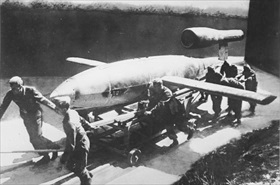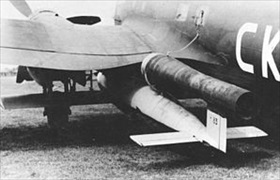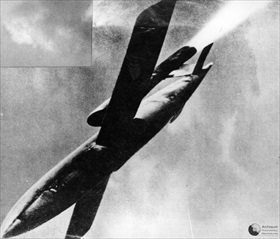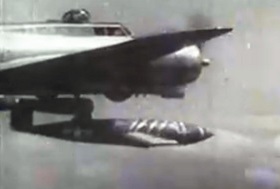LONDON TERRORIZED BY NAZI FLYING BOMBS
London, England · June 13, 1944
Beginning on this date in 1944 in London, one week after the Allied D-Day landings in Normandy, France (Operation Overlord), the Germans unleashed their pilotless flying “retaliation weapon,” Vergeltungswaffe‑1, on England. Only one of ten V‑1 flying bombs launched that day caused any casualties—eight civilians killed when a V‑1 struck next to a railway bridge. Conceived in 1937 as a radio-controlled flying drone for use in target practice, these “buzz bombs,” so-called for the coughing and putt-putting sound their pulsejet engine made, turned into one of the crudest, cheapest, and simplest terror weapons ever made. Flying at an operating speed of 400 mph and an altitude of between 2,000 and 3000 ft, the “buzz bombs” (also known as “doodlebugs”) were difficult to bring down at first. Barrage balloons weren’t terribly effective, bringing down only 300. Flak guns were effective when paired with the simple computers of the time. RAF pilots developed a technique of “tipping” a V-1, meaning a pilot approached the flying bomb and tipped his wing onto that of a V‑1 to knock it off balance, sending it careening to earth. The most successful pilot downed 60 of these cruise missiles this way. Adolf Hitler hoped the daily rain of these two-ton missiles would force London’s evacuation (one million people did leave), weaken Britain’s resolve to stay in the war, and snatch a German victory from the jaws of looming defeat after the Western Allies had firmly established themselves on the European continent. Launched from fixed sites in France and Holland or from aircraft, 3,531 flying bombs reached England, with 2,420 falling on Greater London. At its peak, over a hundred V‑1s a day were fired at southeast England, which acquired the sobriquet “Hell Fire Corner.” The bombs killed 6,184 people, seriously injured another 17,981, and destroyed or damaged 100,000 homes until the last V‑1 site in range of the British Isles was overrun by Allied forces in October 1944. The successor to the V‑1 proved even deadlier—a true shock-and-awe weapon feared for its supersonic speed, silent approach from 50–120 miles high, and awful devastation. About 3,500 V‑2 rockets were fired at London and other cities between September 8, 1944, when the first V‑2 landed on British soil, and the end of March 1945.
[amazon_carousel widget_type=”ASINList” width=”600″ height=”200″ title=”Recommended Reading” market_place=”US” shuffle_products=”False” show_border=”False” asin=”1848842597,1841767913,0306812924,0811733874,1849087067,1781593868,0007112637,1844156842,1846032474,1602397058″ /]
V-1 “Buzz Bombs”—Nazis’ Crude, Cheap, Simple Terror Weapons
 |  |
Left: A German crew rolls out a V‑1 in 1944. The Germans manufactured close to 32,000 of these flying bombs. V‑1 launch sites in France were located in nine general areas, four of which had launch ramps aligned toward London, and the remainder toward Brighton, Dover, Newhaven, Hastings, Southampton, Manchester, Portsmouth, Bristol, and Plymouth. To help counter the V‑1 threat, 23,000 men and women with anti-aircraft guns, radar, and communications networks were installed along the English coast. RAF squadrons, consisting of the newest Spitfires, Hawker Tempests, and even Gloster Meteor jets, were also employed. Together these defenses destroyed 3,957 V‑1s.
![]()
Right: Luftwaffe Heinkel He 111 H‑22 twin-engine bombers air-launched V‑1s from low altitude over the North Sea toward Britain. Only a few of these aircraft were produced in 1944, when bomber production was largely halted in favor of fighter aircraft.
 |  |
Left: Altogether 10,500 V‑1s were launched against Britain during the war. Little more than half these missiles hit their targets (the figure also includes V‑2s). Bomb disposal teams were dispersed to sites where V‑weapons had failed to explode on impact in order to render them harmless. The last V‑1 launch site was overrun on March 29, 1945, five weeks before war’s end. V‑1s were assembled near Wolfsburg, at the Mittelwerk underground factory and at Allrich in central Germany, at Barth close to the Baltic Sea, and in the Buchenwald concentration camp complex (V‑1 parts).
![]()
Right: From captured V‑1 components both Americans and Soviets built versions of the German cruise missile. The American version was a prototype known as the “Loon,” seen here being launched from a B-17 Flying Fortress during weapons testing in 1944. The intention was to use these flying bombs as a key component of Operation Downfall, America’s knockout punch to Japan. Plans were to produce 1,000 per month. Two U.S. bombs of a radically different nature, dropped on Hiroshima and Nagasaka in August 1945, meant no Loons were ever used against Japan.
Wings of the Luftwaffe: The V-1 Flying Bomb
![]()

 History buffs, there is good news! The Daily Chronicles of World War II is now available as an ebook for $4.99 on Amazon.com. Containing a year’s worth of dated entries from this website, the ebook brings the story of this tumultuous era to life in a compelling, authoritative, and succinct manner. Featuring inventive navigation aids, the ebook enables readers to instantly move forward or backward by month and date to different dated entries. Simple and elegant! Click
History buffs, there is good news! The Daily Chronicles of World War II is now available as an ebook for $4.99 on Amazon.com. Containing a year’s worth of dated entries from this website, the ebook brings the story of this tumultuous era to life in a compelling, authoritative, and succinct manner. Featuring inventive navigation aids, the ebook enables readers to instantly move forward or backward by month and date to different dated entries. Simple and elegant! Click 











